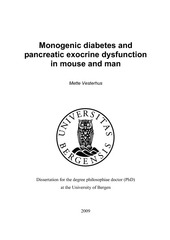| dc.contributor.author | Vesterhus, Mette | en_US |
| dc.date.accessioned | 2010-01-05T10:45:57Z | |
| dc.date.available | 2010-01-05T10:45:57Z | |
| dc.date.issued | 2009-12-04 | eng |
| dc.identifier.isbn | 978-82-308-0904-4 (print version) | en_US |
| dc.identifier.uri | https://hdl.handle.net/1956/3715 | |
| dc.description.abstract | Exocrine and endocrine pancreatic disease is often observed to occur together. The close colocalization of the endocrine and exocrine tissues within one organ, as well as their common embryological ancestry, have given rise to hypotheses concerning the pathogenesis of such diseases. However, often two questions remain: Which cell type is the origin of the disease? And what is the fundamental pathological process? Principally, there are three possible sites of action in combined exocrine and endocrine pancreatic disease: The exocrine cells, the endocrine cells, or the common progenitor cells. In order to investigate the association between exocrine function and diabetes further, we studied exocrine and endocrine function as well as pancreatic structure in three different contexts: HNF1A-MODY, HNF1B-MODY and CEL-MODY. Exocrine dysfunction and a striking association with pancreatic atrophy have been reported in HNF1B mutation carriers. Mouse studies have revealed an essential function of Hnf1b in pancreatic development and mouse embryos deficient of Hnf1b exhibit a rudimentary dorsal pancreatic bud. In Paper III, we describe exocrine dysfunction and absence of tissue corresponding to the pancreatic body and tail as evaluated by CT and MRCP in five individuals from two families with HNF1B mutations. Our observations strengthen the evidence for a critical role of HNF1B in the normal development and differentiation of the pancreas and support the notion that HNF1B mutations cause diabetes and exocrine dysfunction based on congenital malformation. HNF1A and HNF1B encode closely related transcription factors, and a similar phenotype for exocrine dysfunction and pancreas structure could be expected. Furthermore, exocrine dysfunction has been observed in 10-30 % of type 1 and 2 diabetes patients, and reduced pancreatic volume has been well described in type 1 diabetes and to some degree in type 2 diabetes. In Paper I we describe for the first time the prevalence of pancreatic exocrine dysfunction in a cohort of patients with HNF1A-MODY. The data in Paper I indicate that 13 % of adult HNF1A-MODY patients had exocrine dysfunction. This was similar to results from the type 1 diabetes control group (19 %) and in line with previous findings in type 1 and 2 diabetic patients, but three times higher than that in nondiabetic controls (4 %). The strong association between endocrine and exocrine dysfunctions as that observed in HNF1BMODY was not paralleled in HNF1A-MODY. In Paper II, we showed that HNF1A-MODY patients had reduced pancreatic volume compared to non-diabetic controls, mimicking the pancreatic volume reduction in type 1 diabetes. Taken together, the findings in Papers I and II indicate that the prevalence of exocrine dysfunction and the structural changes of the pancreas in HNF1A-MODY are different from that characterizing HNF1B-MODY, but similar to that observed in type 1 diabetes, and likely due to insulinopenia. Pancreatic exocrine dysfunction as expressed by fecal elastase deficiency in subjects with diabetes has been claimed to be moderate and clinically irrelevant. This is contradicted by our finding of pathologically high fat excretion in all of the available six patients with fecal elastase deficiency and HNF1A-MODY, 14 out of 17 type 1 diabetes subjects, one of three available type 2 diabetes subjects (Papers I and II), and in seven out of nine subjects with CEL-MODY (Paper IV). Our results support previous observations of a high prevalence of steatorrhea in subjects with diabetes and fecal elastase deficiency. All of our CEL-MODY patients had pathologically low vitamin E levels. Osteopenia or osteoporosis was frequently found, possibly as sequela of undiagnosed exocrine dysfunction. Pancreatic enzyme supplements constitute the main treatment of maldigestion in pancreatic exocrine insufficiency, but the effect on glycemic control in the presence of diabetes has been debated. We studied the effects of enzyme replacement therapy in nine subjects with diabetes and exocrine dysfunction due to mutations in the carboxyl-ester lipase gene (CEL). They experienced immediate alleviation of symptoms, fecal fat excretion was reduced, and vitamin E levels increased. We found no effect of pancreatic enzyme supplements on glycemic control, suggesting that such treatment is safe in a context of diabetes. CEL-MODY is a syndrome of monogenic diabetes and pancreatic dysfunction due to CEL mutations. Diabetes is believed to arise secondary to exocrine dysfunction in CEL-MODY, but the pathogenetic processes are unclear. Investigating a loss-of-function mechanism, we studied the global knockout model (CELKO; Paper V). Female CELKO mice developed mild random fed hyperglycemia and islet hyperplasia; however, no clear phenotype resembling CEL-MODY was demonstrated. In order to explore the hypothesis that disease develop due to an altered cellular function of the mutant protein, we created and studied the TgCEL mouse line expressing the Del1 disease-associated human CEL allele (Paper VI). The mice did not exhibit any endocrine or exocrine dysfunction, however. Further studies remain to be done, particularly to explore the effects of mutant human CEL in a transgenic mouse line. | en_US |
| dc.language.iso | eng | eng |
| dc.publisher | The University of Bergen | eng |
| dc.relation.haspart | Paper I: Diabetes Care 31(2), Vesterhus, M.; Ræder, H.; Johansson, S.; Molven, A.; Njølstad, P. R., Pancreatic exocrine dysfunction in maturity-onset diabetes of the young type 3, pp. 306-310. Copyright 2008 the American Diabetes Association. Full text not available in BORA due to publisher restrictions. The published version is available at: <a href="http://dx.doi.org/10.2337/dc07-1002" target="_blank"> http://dx.doi.org/10.2337/dc07-1002</a> | en_US |
| dc.relation.haspart | Paper II: Journal of Clinical Endocrinology and Metabolism 93(9), Vesterhus, M.; Haldorsen, I. S.; Ræder, H.; Molven, A.; Njølstad, P. R., Reduced pancreatic volume in hepatocyte nuclear factor 1A-maturity-onset diabetes of the young, pp. 3505-3509. Copyright 2008 The Endocrine Society. Reproduced with permission. Published version. The published version is also available at: <a href="http://dx.doi.org/10.1210/jc.2008-0340" target="_blank"> http://dx.doi.org/10.1210/jc.2008-0340</a> | en_US |
| dc.relation.haspart | Paper III: Diabetic Medicine 25(7), Haldorsen, I. S.; Vesterhus, M.; Ræder, H.; Jensen, D. K.; Søvik, O.; Molven, A.; Njølstad, P. R., Lack of pancreatic body and tail in HNF1B mutation carriers, pp. 782-787. Copyright 2008 the authors, journal compilation Diabetes UK. Published by Wiley-Blackwell. Full text not available in BORA due to publisher restrictions. The published version is available at: <a href="http://dx.doi.org/10.1111/j.1464-5491.2008.02460.x" target="_blank"> http://dx.doi.org/10.1111/j.1464-5491.2008.02460.x</a> | en_US |
| dc.relation.haspart | Paper IV: Diabetes Care 31(9), Vesterhus, M.; Ræder, H.; Aurlien, H.; Gjesdal, C. G.; Bredrup, C.; Holm, P. I.; Molven, A.; Bindoff, L.; Berstad, A.; Njølstad, P. R., Neurological features and enzyme therapy in patients with endocrine and exocrine pancreas dysfunction due to CEL mutations, pp. 1738-1740. Copyright 2008 the American Diabetes Association. Full text not available in BORA due to publisher restrictions. The published version is available at: <a href="http://dx.doi.org/10.2337/dc07-2217" target="_blank"> http://dx.doi.org/10.2337/dc07-2217</a> | en_US |
| dc.relation.haspart | Paper V: Vesterhus, M.; Ræder, H.; Kurpad, A. J.; Kawamori, D.; Molven, A.; Kulkarni, R. N.; Kahn, C. R.; Njølstad, P. R., 2009, Pancreatic function in carboxyl-ester lipase knockout mice. Full text not available in BORA. | en_US |
| dc.relation.haspart | Paper VI: Vesterhus, M.; Ræder, H.; Johansson, S.; Kurpad, A. J.; Kawamori, D.; Molven, A.; Kulkarni, R. N.; Kahn, C. R.; Njølstad, P. R., A transgenic mouse model for the syndrome of diabetes and pancreatic exocrine dysfunction. Full text not available in BORA. | en_US |
| dc.subject | Pancreatic Diseases | eng |
| dc.subject | Diabetes mellitus | eng |
| dc.title | Monogenic diabetes and pancreatic exocrine dysfunction in mouse and man | en_US |
| dc.type | Doctoral thesis | |
| dc.rights.holder | Mette Vesterhus | |
| dc.subject.nsi | VDP::Medisinske Fag: 700::Klinisk medisinske fag: 750::Endokrinologi: 774 | nob |

